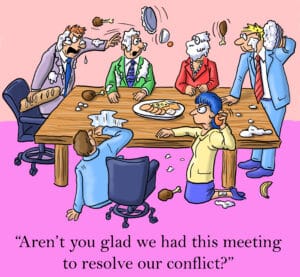Leadership and Healthy Conflict
Healthy conflict: Good. Unhealthy conflict: Bad. There endeth the first lesson…
The key, of course, is knowing the difference between the two.
I frequently say that when reasonably intelligent, well-intentioned people disagree, the organization is better served. 
By reasonably intelligent, I don’t mean an IQ number — just that the person communicating has enough mental snap to understand and discuss the issues at hand. And by well-intentioned, I’m simply referring to those without some boneheaded personal agenda.
The latter, as you’ve likely surmised, is the tough one.
So, we’re working on a complex project with a client. Opinions are buzzing around like mosquitoes during an August Houston evening. We’re cussing, discussing, arguing, persuading, etc. Generally a good time being had by all… and then it happens:
Unhealthy conflict rears its ugly head.
How do we know? Simple… conflict bridges from healthy to unhealthy when those involved in a difference are no longer willing or able to consider others’ views and alternatives, and thereby set up a win-lose confrontation. Enter emotion, stage right.
No longer willing or able to consider others’ views and alternatives. Even if baked in truth, simmered in fact, and stewed in verifiable data. In other words, we’ve begun using emotions alone to decide the fate of the discussion. Logic has left the building…
You know how you can tell? You hear phrases like, “Yea, well, I just don’t agree…” or “I hear you, I just believe you’re wrong (or whatever emotional outcome is desired).” These, and phrases/words like them, mean we’ve entered the unhealthy zone of conflict, and we’ve got to find some ways to get back to healthy conflict. For some methods and tools, see my BrazenLeader blog post, same subject.

- Most conflict is born of miscommunications. That’s right — the vast majority of conflict we see and enjoy are driven by communications missteps, rather than an argument of facts.
That’s why the “Logic has left the building…” comment above. Factual arguments seldom lead to unhealthy conflict. Disagreements, yes. Arguments, maybe. Near-violent discussions, sometimes. But unhealthy conflict? Rarely, since the very basis of unhealthy conflict is an emotional attachment to a position. That attachment was probably solidified when someone challenged the position with opinion, not fact.
- Understanding needs versus wants is the key to resolution. Most of the time, conflicts occur when we focus on our wants instead of our actual needs. If both parties (or however many are involved) would instead determine and focus on their needs, we could make immediate headway.
“I need all deliveries to be on time” is likely a want. “It’s important that deliveries be made with enough time for me to inventory and prepare the parts for installation — about 45 minutes — prior to forwarding to manufacturing” is an underlying need that drives more timely deliveries. “On time” is a performance standard that doesn’t necessarily represent a factual need — a want. “In time to inventory…” is a need based on demonstrable fact. See the difference?
- Unresolved conflicts degrade trust. Always.
Sometimes we “get over” a conflict, meaning that we force civility, feign acceptance, and disguise acquiescence as agreement. But the conflict, yet unresolved, still exists. And as long as it exists between people, the level of trust will decline. Since trust is the very currency of leadership, and since enhanced levels of trust allow and encourage discretionary effort, these unresolved conflicts are damaging — to both the leader involved as well as the organization as whole. 
When you see a conflict go to the dark side — unhealthy conflict — recognize it for what it is, and address as soon as humanly possible.
You’ll be better for it, as will others.
Exemplary efforts are what we do, as leaders. Critical here when dealing with unhealthy conflict.

